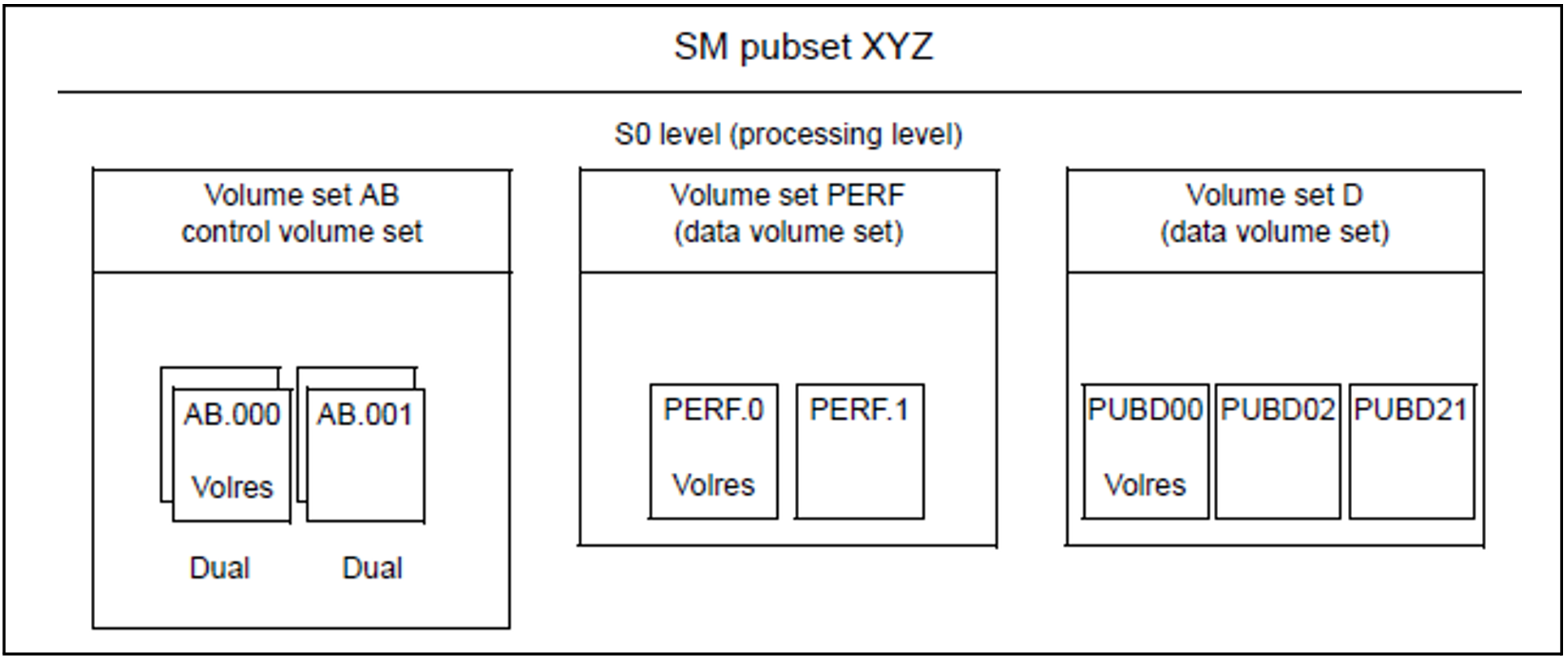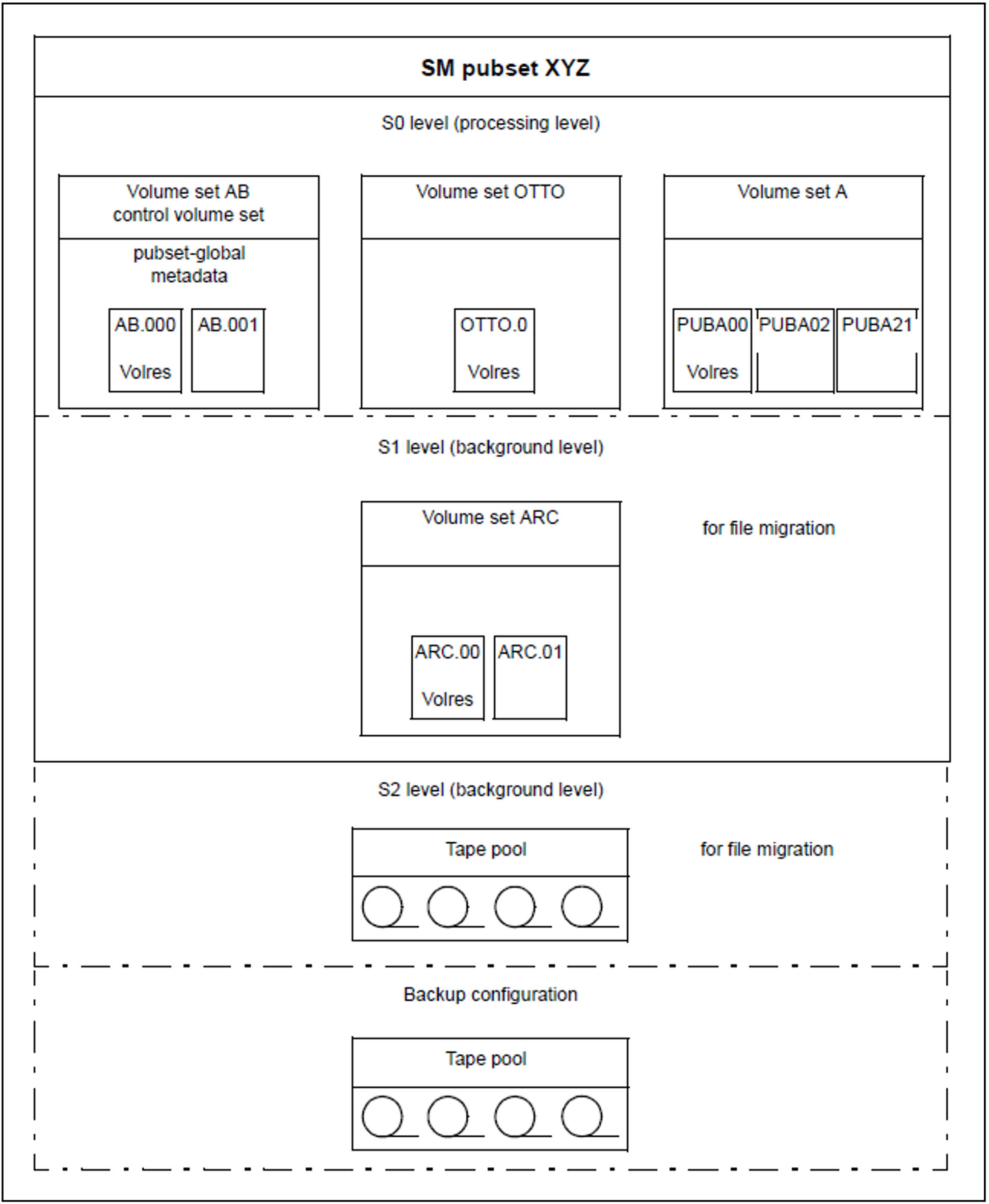An SM pubset consists of one or more volume sets which, as with an SF pubset, consist of a group of several homogeneous disks. A volume set can only be operated within the SM pubset. An SM pubset can consist of a maximum of 255 volume sets.
The control volume set has a special role among the volume sets. The control volume set is used for storing all pubset-global metadata of the SM pubset. The control volume set must therefore always be available and cannot be removed from the pubset.
The example below shows the structure of an SM pubset with the three volume sets AB, PERF and D:
Volume configuration of an SM pubset (example)
If the file “LST.PHONE” exists under the user ID “ALLKIND” on one of the volumes in any of the volume sets of the XYZ pubset, its path name is: “:XYZ:$ALLKIND.LST.PHONE”, i.e. the internal structure of the SM pubset and where the system stores files is generally irrelevant for the user.
Properties of SM pubsets
The services offered are volume-set-specific, i.e. because of its properties, each volume set represents a special service type within the SM pubset. Volume sets with the same properties are assigned to the same service type. When a file is created, the system decides which volume set is most suitable as a file storage location with respect to the requirements of the user (performance, availability, use of special applications).
Within the SM pubset files can be relocated to a different volume set without changing the address, i.e. the relocation is not visible for the user.
An SM pubset can be extended with or reduced by empty volume sets during operation.
Empty volumes can be added to separate volume sets or removed from them.
If a single volume in an SM pubset fails, the damage is limited to the volume set concerned. This means that all the files on this volume set may be damaged, but the rest of the pubset is not affected and can be used further without interruption.
If the control volume set fails, the complete SM pubset is taken to be failed. Systems support should therefore apply special fail-safe measures for the control volume set by using the mirror functions (DRV or RAID1) . However, an SM pubset that contains volume sets operated with DRV cannot be used as a shared pubset.
SM pubsets cannot be used as home pubsets.
Paging files can be set up on SM pubsets. If the paging files are used then only the volume sets to which the paging volumes belong are checked for external allocations.
Properties of volume sets
A volume set is identified by a volume set ID, which forms the main part of the VSN for all volumes in the volume set.
All volumes in the set have a uniform disk format (K, NK2, NK4) and allocation unit.
Each volume set possesses a so-called Volres which mainly contains the physical configuration of the volume set.
Only one cache area can be activated for a volume set.
Each volume set forms a sub-container for complete files, i.e. single files cannot be spread over several volume sets.
A volume set can adopt the following operating states:
DEFECT
the volume set is defective
DEFINED-ONLY
the volume set is defined but not accessible
IN-HOLD
the volume set is temporarily not functional
NORMAL-USE
the volume set is functional and accessible
CONTROL-VOLSET
the volume set is the control volume set
The control volume set contains:
the pubset configuration file (pubset definition file) (this file contains a list of all volume sets belonging to the SM pubset)
special catalogs for job variables, migrated files, no-space files and files on private volumes
the user catalog
the guards catalog
SM pubsets with background levels
An SM pubset must contain a processing level.
Pubsets can be provided with background levels with the help of the software product HSMS. These form a three-level storage hierarchy together with the processing level with respect to access time, availability and costs:
S0 level (for the processing level)
S1 level (for the background level available online)
S2 level (for the background level formed from volumes which can be accessed offline)
If files are not processed for long periods, it is advisable to migrate them to a more economical background level.
In SM pubsets, the S1 level is implemented by a volume set belonging to the pubset, which must be reserved exclusively for this purpose. A tape pool made up of magnetic tapes (or MTCs) is used as the volume for the S2 level. The background levels are assigned exclusively to an SM pubset and cannot be used by more than one pubset. The metadata required for using the background levels, such as the migration archive directory, is on the SM pubset itself on the control volume set.
In the example below, the SM pubset with the catalog ID XYZ consists of three volume sets in the processing level.
Figure 9: SM pubset structure with HSMS configuration


